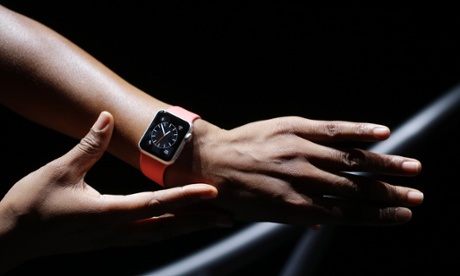
Can wearable technology ever be stylish? That is the question that former Burberry boss Angela Ahrendts, alongside Apple’s burgeoning team of fashion and design talent, has been brought in to answer as the company launched its first piece of wearable technology – the Apple Watch.
And despite Ahrendts being absent from the stage at the Flint Center for the Performing Arts today, the Apple Watch collection bears the unmistakable imprimatur of the company’s new head of retail.
“We set out to make the best watch in the world,” Said Tim Cook, Apple’s CEO, before finally revealing the tech world’s worst kept secret, the Apple Watch. “We’ve been working incredibly hard for a long time on an entirely new product. And we believe this product will redefine what people expect from its category.”
The launch of three distinct collections – Apple Watch, Sport and Apple Watch Edition – mimicked the traditions of a fashion brand, with each collection aimed at a different demographic, with the latter clearly designed to capture the luxury fashion customer.
Three Apple Watch collections - standard, Sport and 18K gold Apple Watch Edition. Liveblog: http://t.co/WomVQAXkob pic.twitter.com/83aLsCxWg6
— Wilson Rothman (@wjrothman) September 9, 2014
Jony Ive, Apple’s vice-president of design, has overseen a range of watches that boast numerous digital functions including sensory touch, interfacing and “a rotary dial that translate into data” (a scroll button). But the emphasis was also on a watch that “is as much about technology as it is style and taste”.
By creating a collection (in stores spring 2015) that features entry point watches at $349 (£217) alongside the sleekly designed – and almost certainly more expensive – Apple Watch Edition devices, which resemble high-end luxury jewellery, Apple’s design team has succeeded in overseeing a product whose aesthetic meets the standards of its technology.
“Apple is treating wearable technology the way that a fashion house treats an accessories line,” said Ben Thompson, editor of Statchery.com. “They have always created fashionable products but where they found the biggest success was personal devices.
“If you look at the way handbags have become statement items, and your choice of handbag tells the world something about who you are, I suspect that Apple will be going this way with the wearables. They’ll begin with two prototype products and later there will more options to follow, and the hope is to create something that becomes as successful as the luxury handbag market.”
Apple products have never been short on style but today’s event saw a heavy focus on fashion that began in the same week the company announced that acclaimed designer Marc Newson will be joining a team that already includes Musa Tariq, formerly of Nike, and Paul Deneve, previously chief executive of Yves Saint Laurent.
For the Apple Watch launch launch Anita Borzyszkowska, a fashion industry PR heavyweight, was hired by Apple to recruit a wide range of fashion journalists and Alexandra Shulman, editor of British Vogue, was among the guests.
Cupertino the centre of attention for the #AppleLive event in 3.5 hours. I'm looking forward to a life-changing watch @britishvogue
— Alexandra Shulman (@AShulman2) September 9, 2014
“Ahrendts is a talented executive,” says Lauren Indvik, a former tech writer who currently edits Fashionista.com. “When she started at Burberry, her own executives weren’t even wearing Burberry; it was a ‘has been’ – a waning brand. She left it positioned as a strong heritage brand that was also a digital pioneer, and cool and covetable because of that. She also transformed Burberry from a wholesaler to a direct retail business, and grew the business substantially in China – all of which align with Apple’s own goals pretty neatly.”
When the 54-year-old departed Burberry in 2013 she left a company whose value had risen by $3bn (£1.9bn) during her eight years at the helm of British fashion’s most established heritage brand. Ahrendts helped implement a digital strategy that revived Burberry’s image as both youthful and international. At Burberry she spotted the zeitgeist before the fashion world became obsessed with Instagram and celebrity social media stars. Now Apple are doing the same, as their wearable tech strategy features a range of biometrics and fitness tracking functionality.
LATEST | Apple’s Watch marks its entry into wearables http://t.co/doWqXHcaHE pic.twitter.com/X6mt2VPXSi
— TechCentral (@TechCentral) September 9, 2014
This strategy, alongside Apple’s high-profile fashion appointments, makes sense in a fashion market that has seen a huge spike in the sale of gym wear and accessories. From activity trackers to yoga leggings, the international sports apparel market is set to grow to $178 billion by 2019, according to figures published by the Business of Fashion.
Apple’s presentation focused on the Apple Watch’s fitness tracking capability and tech innovation, but the real coup was that the company managed to make wearable tech the one thing it has never been before: fashionable.
- iPhone 6 and iOS 8 drag mobile gaming to next level
- How Twitter reacted when Apple’s launch didn’t go to plan

